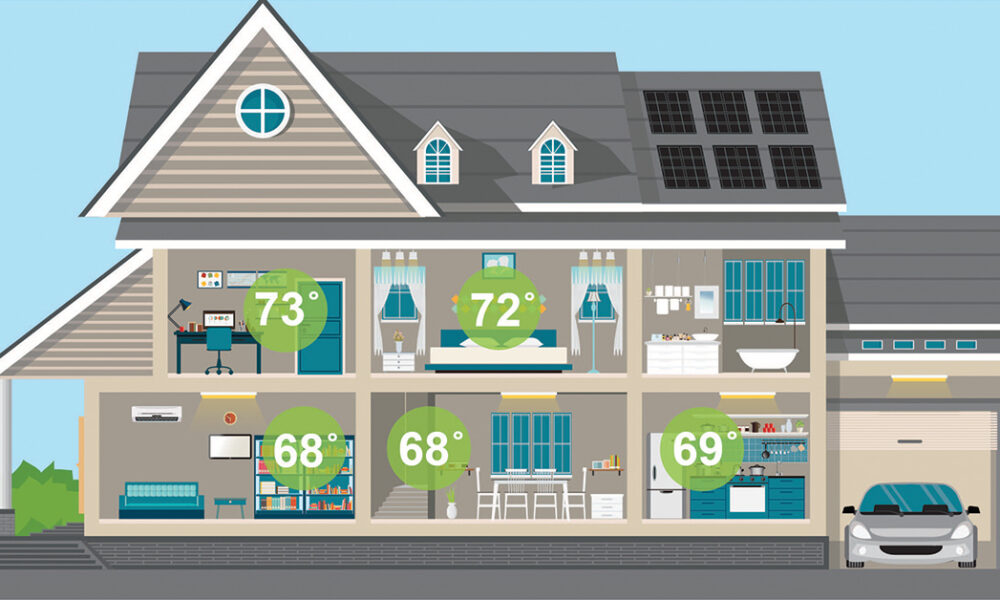Why Does My House Have So Many Hot and Cold Spots?

Have you or have you not passed from one room into another in an Aussie home and felt like you have just crossed from the Outback into Antarctica? One moment you’re perspiring in a Darwin summer; the next you’re shivering out in the Snowy Mountains. These hot and cold spots in your house will indeed work against you in making it comfortable to live in all year round.
If you’ve ever wondered why your house seems to be gambling away its temperature, you’ve come to the right place. We will now look at what may be behind those pesky temperature disturbances and what can be done practically to maintain a comfortable feel inside your house.
Poor Insulation: The Silent Temperature Thief
Home insulation is among the major causes of uneven temperatures. Many homes, particularly the older ones that predate energy regulations, have insulation that is either almost non-existent in some areas or just really thin and patchy. These houses might let in heat during summer or drain heat in winter, leaving some areas painfully hot and others chillingly cold. For example, the sunlight streaming in will basically steam the living room if the walls or roof are inadequately insulated, while the bedrooms will stay cool due to shade.
Homes in places like Sutherland that experience extreme seasonal temperature variability are especially prone to this problem. If insulation is, indeed, the cause of your headache, you may well want to have an expert come around and take a look at your home setup. A good insulation job done in your walls, ceiling, or even under the floor can go a long way towards balancing temperatures. Not to mention the savings it’ll bring to your energy bills.
Inefficient Heating and Cooling Systems
One more reason for hot and cold spots may be that the HVAC system has not been performing adequately due to its old age. Thus, if the system cannot push conditioned air well inside the house, some areas may feel contrarily cold and stifling to the others. This holds even truer for very large houses being separated into levels since air has distances to reach every nook and cranny.
Improper maintenance may cause the ducted systems to leak or break the way of airflow.
- Dirty filters prevent the weather-conditioned air from being distributed effectively.
- Inefficient design of ductwork can do the same.
For people in the Sutherland area, professional HVAC services Sutherland can come to the rescue, diagnose, and ensure your system is operating in prime condition. Regular maintenance together with cleaning or sealing of your ducts will go far in curing the meltdown of the temperature switch.
Home Layout and Design Challenges
Sometimes, the makeup of your house itself can add to hot and cold spots. Open-plan living is in fashion, but such large and open spaces tend to be the least accommodating for mounting systems to maintain temperatures. Rooms with big windows facing strong sun can heat up fast, whereas secluded rooms in the shade stay cool. High ceilings, narrow hallways, or really anything that kills air circulation in your home just increases your ability to feel temperature fluctuations.
In particular, older houses were not always constructed considering the setup for modern climate control. For instance, an expansive Queenslander might be magnificently ventilated in summer but unable to fend off the cold in winter. For homes having awkward layouts, perhaps a whole home renovation is in order to fix the airflow and insulation. Other things to consider might be ceiling fans, better windows, or even vents placed with forethought to keep the temperature across your home even.
Air Leaks and Draughts
Ever felt a sudden gush of cold air around your windows or doors? Air leaks and draughts can certainly contribute to the formation of hot-and-cold spots. Gaps near windows and doors or even around electrical outlets let warm air in during summers or cold air in during winters, thus giving rise to uneven temperature. This is a growing concern for coastal areas like Sutherland Shire in Sydney, as salty air combined with humidity causes window seals to wear out with time.
Gaps can be sealed easily enough. Weatherstripping around doors and windows, caulking gaps, and putting in draught stoppers can all go a long way in generating comfort. If unsure of the leak spots, try holding a candle next to the suspicious cracks during a windy day; any flickering in the candle flame is direct evidence of a leak. Bigger houses or houses with more happening systems could greatly benefit from professionals of instrumentation and control to ensure leaks are pinpointed and sealed, so the home remains a comfortable place.
Lifestyle and Usage Patterns
Believe it or not, how you use your home can actually create these hot and cold zones. There are times when baking becomes a pastime of the oven, and the heat from such appliances is warmer than the rest of the house. Similarly, rarely used rooms like an extra guest bedroom may not have enough flows of air through them, making those rooms cold.
Your use of heating and cooling systems must also be considered. Running the AC only in selected parts of the house or purposely shutting vents in unused rooms may create unexpected temperature differences. Try keeping the doors inside open for better airflow and throw in a couple of fans for even air circulation. You may also want to check your zoned climate control system settings to ensure you’re not being really hard on or under on cooling or heating in any one area.
Solutions to Banish Hot and Cold Spots
Having explored some of those prime causes for the hot and cold spots, let us move on to some cures for Cool and Hot.
- Begin with the insulation – the roof, especially, as that’s the prime pathway for heat gain or heat loss.
- If it has been a lamely long time since the heating or cooling system was serviced, consider getting it serviced professionally now. Then, a few simple adjustments, such as cleaning the filters or adjusting the dampers, might be all it takes to make a big difference.
- Next, consider the flow of your house. If renovation is in the cards, try to think about improving the flow with bigger windows or vents or even a more open layout.
- Draught-proofing is another quick-fix-win procedure: grab some weatherstripping from your local hardware store and set about sealing those areas.
- Lastly, try to be mindful of how you use your house. Open doors, keep the air circulating with the help of a ceiling or stand fan, and do not blast the air con in just one room.
When to Give the Pros a Call
Some fixes can be handled by a DIYer, whilst others will require the caring service of a contractor. If the temperature issues are persistent, it is high time experts consider your insulation, HVAC system, or even general design of the house. Local experts in parts like Sutherland will deliver solutions best suited to the climate unique to that region. Professional advice can save you a considerable amount of time, money, and aggravation – whether it may be just installing another system or completely doing away with a system.
The Conclusion: Temperature Tantrums – Free For All
Hot and cold spots in a house have as gingerly been permitted into the life of mortals for an eternity. By addressing the likes of poor insulation or air conditioning, inefficient layouts, air leaks, or even your own usage habits, you can create a home that stays comfortable through all seasons. Work their way up, from basic zacks such as draught-proofing to setting your air conditioner a little differently, and if it’s the real biggie, get a pro in. Your home should be your own sanctuary, not a temperature rollercoaster.





